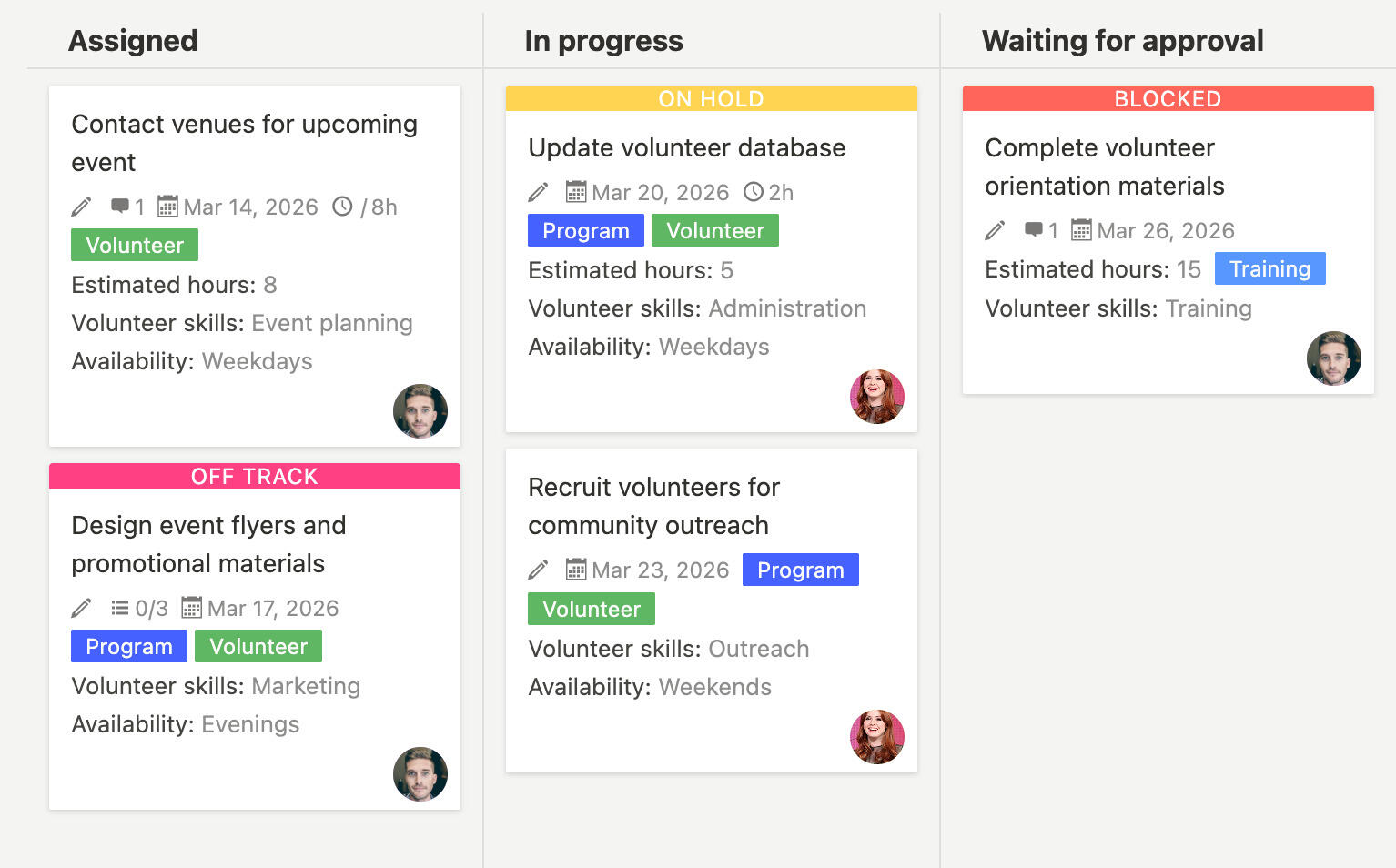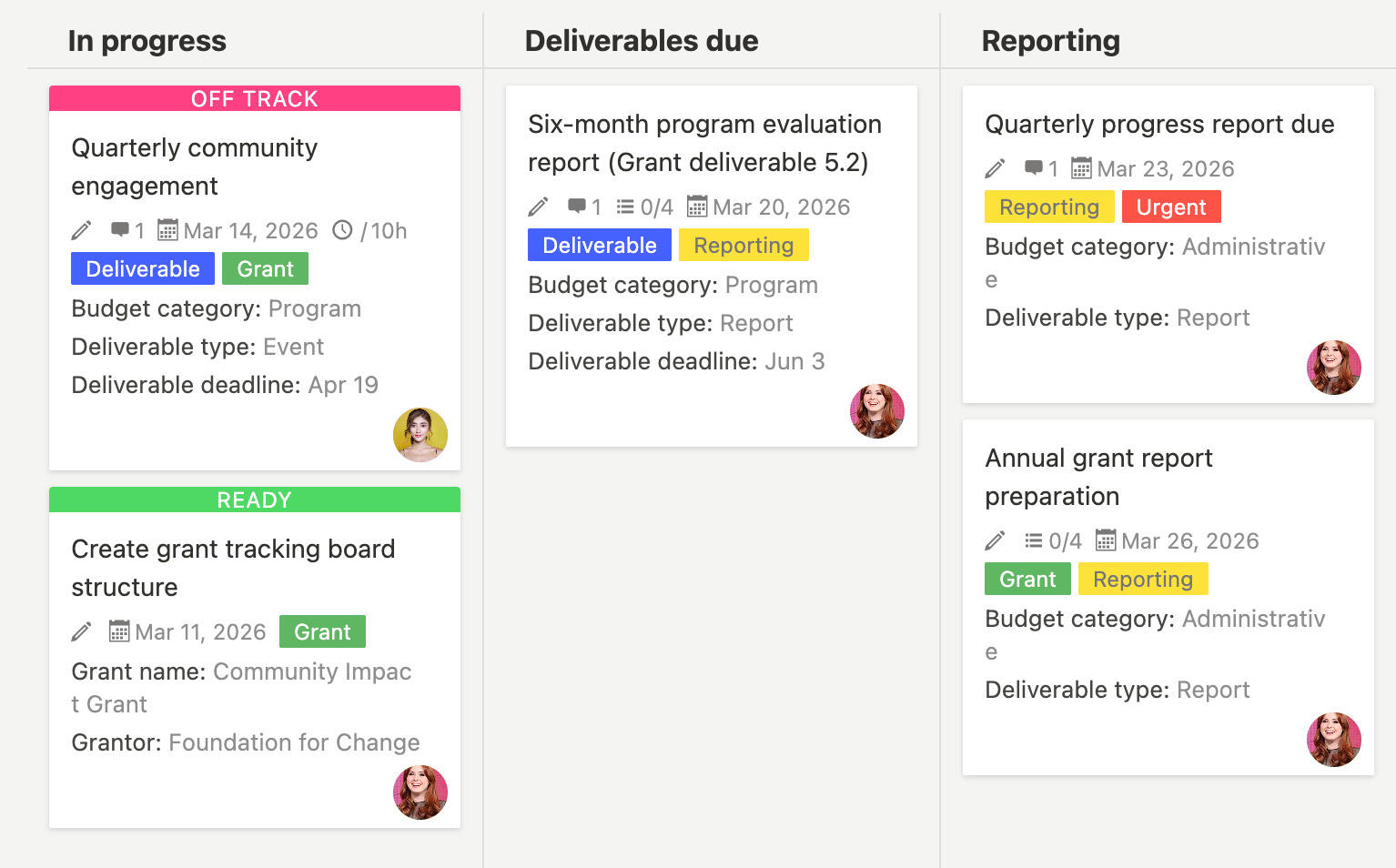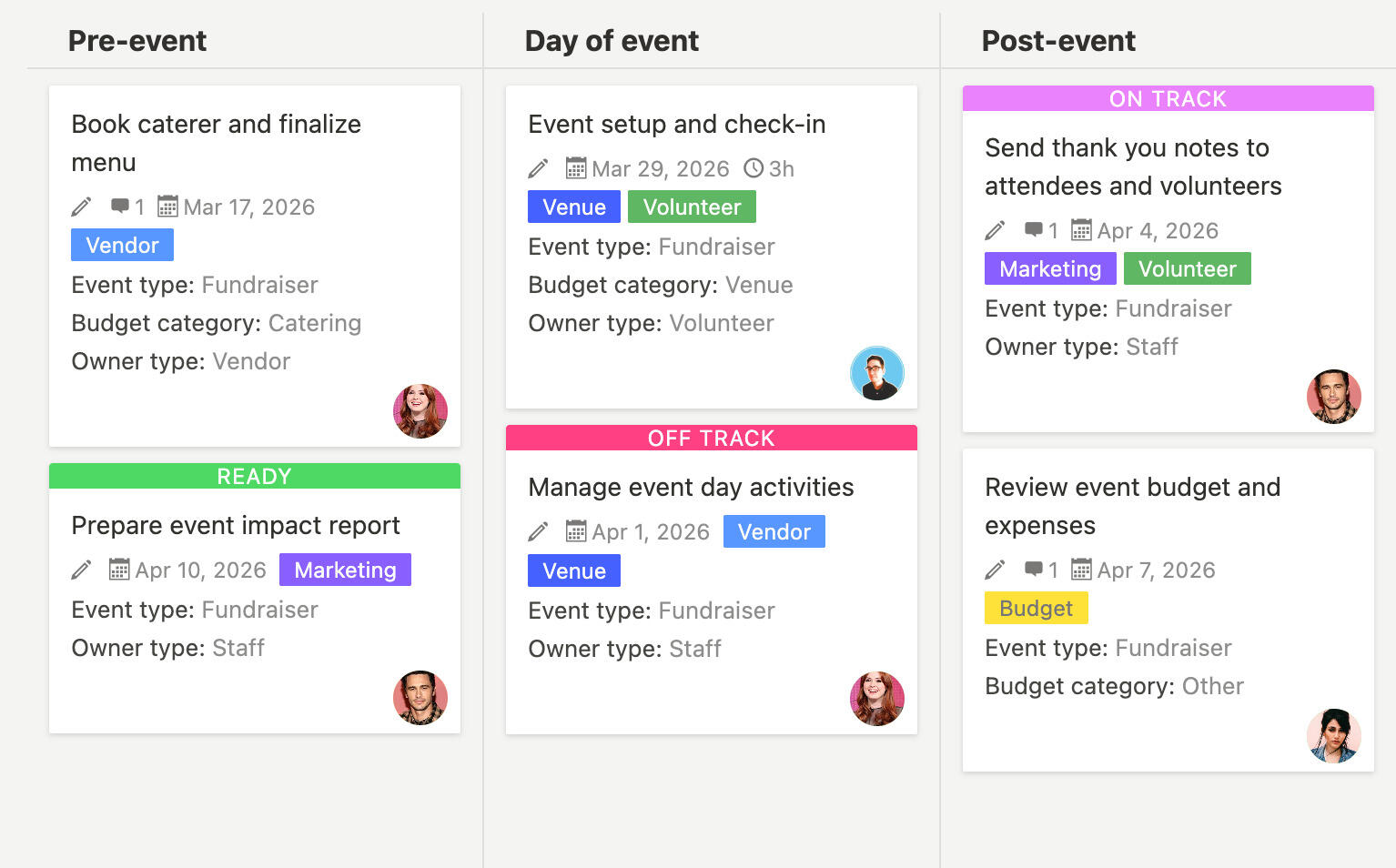A practical guide to project management for non-profits
Contents
- What makes project management different for non-profits?
- How do you manage projects with volunteer teams?
- How do you track grant-funded projects and reporting requirements?
- How do you coordinate event planning and campaign management?
- Which project management tools work for non-profit budgets?
- What do experts recommend for non-profit project management?
- Conclusion
Non-profit organizations face unique project management challenges that most business software ignores. Limited budgets, volunteer teams, grant reporting requirements, and complex stakeholder relationships make traditional project management tools feel too expensive or too complicated. But the work still needs to get done - events need planning, campaigns need execution, and programs need coordination across teams that may not share the same office or schedule.
When project status lives in email threads, spreadsheets, and memory, accountability disappears. Volunteers miss deadlines because no one knew who owned the task. Grant reports get delayed because deliverables were not tracked. Events run into problems because communication fell through the cracks. A shared project board solves this by making work visible, owners clear, and progress easy to follow for everyone involved.

A lightweight tool like Breeze helps non-profits track who owns what and what needs attention next, without forcing a big budget or complex setup. A shared workflow keeps conversations tied to the work instead of buried in email, and keeps volunteers and staff aligned on the same goals.
This guide covers how non-profits can manage projects effectively despite limited resources, volunteer coordination needs, and complex reporting requirements.
Key takeaways
- Non-profit projects need different management approaches than for-profit work, especially around volunteer coordination and grant reporting.
- Volunteer teams require clear ownership, flexible scheduling, and visible progress to stay engaged without micromanagement.
- Grant-funded projects need strict deadline tracking, deliverable documentation, and compliance reporting that general project tools often miss.
- Event planning and campaigns benefit from shared workflows that coordinate volunteers, vendors, and timelines across multiple stakeholders.
- Simple, affordable tools like Breeze provide structure without heavy setup or per-user pricing that strains non-profit budgets.
- Focus on visibility and consistency - these qualities drive better collaboration and accountability in resource-constrained environments.
1. What makes project management different for non-profits?
Non-profit projects face constraints that most business software ignores: tight budgets, volunteer teams, grant compliance, and stakeholder accountability. These differences require lighter tools, clearer communication, and more flexible workflows than traditional project management approaches. A tool like Breeze fits these needs by providing structure without heavy setup or per-user pricing that strains non-profit budgets.
Budget constraints mean non-profits cannot afford expensive per-seat licenses or complex enterprise systems. They need tools that work for small teams with occasional volunteers, not hundred-person organizations. Volunteer coordination adds complexity because volunteers have different availability, commitment levels, and technical skills. They need clear ownership and visible progress without micromanagement. Grant reporting requires strict deadline tracking and deliverable documentation that general project tools often miss. Stakeholder accountability means boards, donors, and grantors need visibility into progress without getting buried in daily task details.
Here's how non-profit project management compares to for-profit work:
| Aspect | For-profit projects | Non-profit projects |
|---|---|---|
| Team composition | Paid staff with consistent schedules | Mix of paid staff and volunteers with variable availability |
| Budget constraints | Profit margins allow for premium tools | Tight budgets require affordable or free solutions |
| Accountability | Performance reviews and salary incentives | Mission-driven motivation, limited formal authority |
| Reporting requirements | Internal progress updates | Grant reports, donor updates, board presentations |
| Timeline flexibility | Business-driven deadlines | Grant deadlines, event dates, campaign timelines |
| Tool complexity | Can invest in training and adoption | Need simple tools volunteers can use immediately |
Research from the Nonprofit Quarterly emphasizes that non-profits need lightweight project management that balances structure with flexibility. Too much process creates bureaucracy that volunteers avoid. Too little structure leads to missed deadlines and unclear accountability. Many organizations struggle with tool adoption challenges that stem from complexity rather than missing features.
The solution is tools that provide visibility without complexity. Breeze lets non-profits create project boards in minutes with custom fields that match grant requirements or event planning needs. Volunteers can see their tasks and deadlines without learning complex workflows. Staff can track progress across multiple projects without switching between tools. Boards can review high-level status without getting buried in daily task details. Understanding what makes project management simple helps non-profits choose tools that volunteers and staff actually use.
2. How do you manage projects with volunteer teams?
Volunteer coordination requires clear ownership, flexible scheduling, and visible progress that keeps people engaged without micromanagement. Volunteers need to know what they own, when it's due, and how their work connects to the mission. Breeze helps non-profits create volunteer project boards that make assignments obvious, deadlines clear, and progress easy to follow for everyone involved.
Volunteer projects break down when tasks are unclear, ownership is vague, or progress is invisible. A volunteer might commit to a task but forget the deadline because it was only mentioned in an email. Another volunteer might not know they are blocking someone else because communication lives in separate channels. A project board solves this by putting every task on a shared board with clear owners, due dates, and status that anyone can check at a glance.
Make volunteer assignments clear and visible
Start with a simple board structure that matches your volunteer workflow. Create lists like New tasks, In progress, Waiting for approval, and Complete. Assign each task to a specific volunteer with a clear due date. Attach any files or context the volunteer needs directly to the task card. Keep the language simple and mission-focused so volunteers understand why the work matters.
In Breeze, non-profits can build volunteer boards with custom fields for volunteer skills, availability, and preferred contact methods. A single board can track all volunteer tasks for a campaign, or you can create separate boards for different programs or events. Simple automation rules can send reminders when deadlines approach or notify staff when a task is blocked. For example, when a task moves to In progress, automatically notify the volunteer's point of contact. When a task is overdue, create a reminder to check in. These small rules keep volunteer projects moving without constant manual follow-up.

Think in terms of engagement for volunteers as well as accountability for staff. Filters that show a volunteer's assigned tasks help them plan their time. A view of overdue tasks reveals where projects are stuck. If you need to report volunteer hours or impact, save a filter for completed tasks by volunteer or by program so you can export data when grantors or donors ask. The more the board answers common questions on its own, the fewer status emails you need to send.
When you are ready to implement this pattern in detail, you can follow proven volunteer project workflows that many non-profits use to keep volunteer coordination structured and consistent.
3. How do you track grant-funded projects and reporting requirements?
Grant projects require strict deadline tracking, deliverable documentation, and compliance reporting that general project tools often miss. Grantors need to see progress and outcomes, not just task completion. Non-profits need to track deliverables, expenses, and milestones in ways that make reporting straightforward. Breeze helps non-profits create grant tracking boards that connect tasks to deliverables, deadlines to reports, and progress to outcomes.
Grant projects break down when deliverables are not tracked, deadlines are missed, or reporting requires hunting through emails and spreadsheets. A grant manager might remember a deliverable is due soon but cannot find the original requirements. A finance team might need expense data for a report but it lives in a separate system. A program team might complete work but not document outcomes in ways that satisfy grant requirements. A grant tracking board solves this by putting every deliverable, deadline, and requirement in one place that anyone can check.
Connect tasks to grant deliverables
Start with a board structure that matches your grant cycle. Create lists like Planning, In progress, Deliverables due, Reporting, and Complete. Add custom fields for grant name, grantor, budget category, and deliverable type. Attach grant documents, requirements, and templates directly to the board or relevant cards. Keep the language aligned with grant terminology so reports are easier to write.
In Breeze, non-profits can build grant tracking boards with custom fields that match grant requirements. A single board can track one large grant, or you can create separate boards for different grants or programs. Simple automation rules can send reminders when deliverable deadlines approach or notify grant managers when reports are due. For example, when a deliverable deadline is two weeks away, automatically notify the program team. When a reporting deadline approaches, create a checklist for required documentation. These small rules keep grant projects on track without constant manual oversight.

Think in terms of reporting efficiency for grant managers as well as compliance for grantors. Filters that show upcoming deliverable deadlines help prioritize work. A view of overdue deliverables reveals where projects are behind. If you need to prepare grant reports, save a filter for completed deliverables by grant or by reporting period so you can export data when grantors ask. The more the board connects tasks to deliverables, the easier reporting becomes.
Research from the National Council of Nonprofits emphasizes that effective grant management requires systems that track both activities and outcomes. Non-profits need tools that connect daily work to grant requirements, not separate systems that create reporting gaps.
When you are ready to implement this pattern in detail, you can follow proven grant project workflows that many non-profits use to keep grant tracking structured and compliant.
4. How do you coordinate event planning and campaign management?
Event planning and campaigns require coordination across volunteers, vendors, timelines, and multiple stakeholders with different schedules and priorities. Events have fixed dates that cannot move, campaigns have deadlines that create urgency, and both require communication that keeps everyone aligned. Breeze helps non-profits create event and campaign boards that coordinate tasks, deadlines, and communication in one place.
Event projects break down when tasks are not coordinated, vendors are not managed, or volunteers are not aligned. An event coordinator might know a vendor is needed but cannot track when contracts are due. A volunteer might commit to a task but not know other volunteers are waiting on them. A campaign manager might need to report progress but cannot see which tasks are complete. A shared board solves this by making every task, deadline, and dependency visible to everyone involved.
Coordinate multiple stakeholders and timelines
Start with a board structure that matches your event or campaign timeline. Create lists like Planning, Pre-event, Day of event, Post-event, and Complete for events. For campaigns, use lists like Strategy, Launch preparation, Active campaign, Wrap-up, and Complete. Add custom fields for task type, owner type (staff vs volunteer), vendor contact, and budget category. Attach event documents, vendor contracts, and campaign materials directly to relevant cards.
In Breeze, non-profits can build event boards with custom fields that match event planning needs. A single board can track one large event, or you can create separate boards for different events or campaigns. Simple automation rules can send reminders when vendor deadlines approach or notify coordinators when tasks are blocked. For example, when a task moves to Pre-event, automatically notify the relevant vendor or volunteer. When the event date is one week away, create a checklist for final confirmations. These small rules keep events and campaigns on track without constant manual coordination.

Think in terms of coordination efficiency for coordinators as well as clarity for volunteers and vendors. Filters that show tasks by owner type help balance workload between staff and volunteers. A view of tasks due this week reveals what needs immediate attention. If you need to report event or campaign impact, save a filter for completed tasks by category or by outcome so you can export data when donors or boards ask. The more the board shows dependencies and deadlines, the smoother events and campaigns run.
When you are ready to implement this pattern in detail, you can follow proven event and campaign workflows that many non-profits use to keep coordination structured and consistent.
5. Which project management tools work for non-profit budgets?
Non-profits need project management tools that are affordable, easy to learn, and flexible enough to handle volunteer teams, grant tracking, and event planning. The right choice depends less on feature lists and more on how quickly your team can set up a workflow and keep it accurate week after week. Breeze offers affordable pricing and simple setup that fits non-profit budgets and volunteer-friendly workflows.
Most non-profits cannot afford expensive per-seat licenses or complex enterprise systems. They need tools that work for small teams with occasional volunteers, provide nonprofit discounts, and offer simple interfaces that volunteers can use without training. The three options below are common starting points for non-profits. The right choice depends on team size, volunteer involvement, and budget constraints.
| Criteria | Breeze | Asana | Trello |
|---|---|---|---|
| Non-profit pricing | Affordable with nonprofit discounts available | Nonprofit discounts in higher tiers | Free tier with limits, paid plans for teams |
| Ease of use | Quick setup and clear layout for volunteers | Feature rich with steeper learning curve | Very simple but basic at scale |
| Volunteer-friendly | Simple interface, minimal training needed | Requires more training for volunteers | Very simple for occasional users |
| Grant tracking | Custom fields and automation for deliverables | Advanced features in paid tiers | Limited without add-ons |
| Event planning | Flexible boards for events and campaigns | Strong for complex events | Good for simple event planning |
| Budget fit | Accessible for small and mid-sized non-profits | More expensive for core features | Free tier with limits, paid plans scale |
Use the table as a starting point, not a verdict. The tool that wins is the one your team keeps up to date. If volunteers avoid the system, no feature list will save the process. Pilot with one volunteer project or one grant tracking board. If the workflow stays current for four weeks, you picked a workable approach.
Breeze offers nonprofit discounts and simple interfaces that make it easy for volunteers to see their tasks and deadlines without learning complex workflows. Staff can track progress across multiple projects without switching between tools, and boards can review high-level status without getting buried in daily task details.
6. What do experts recommend for non-profit project management?
Research and expert guidance point toward lightweight systems that balance structure with flexibility. Non-profits need tools that provide visibility without complexity, accountability without micromanagement, and reporting capabilities without heavy setup. According to the Nonprofit Quarterly, effective non-profit project management requires systems that volunteers can use immediately and staff can maintain without constant training.
Grant management research emphasizes the importance of connecting daily work to grant requirements. The National Council of Nonprofits notes that non-profits need tools that track both activities and outcomes, not separate systems that create reporting gaps. The takeaway is practical: the more visible and repeatable the process, the more reliable the outcome. A straightforward project structure makes that possible without a heavy toolset.
Volunteer management studies show that clear ownership and visible progress improve volunteer engagement. Research from the National Council of Nonprofits indicates that volunteers stay engaged when they can see how their work connects to mission outcomes and when they have clear deadlines without constant check-ins. The point is not a complex system for its own sake; it is a consistent way to show impact and maintain accountability.
Breeze supports these recommendations by providing simple project boards that volunteers can use immediately, grant tracking that connects tasks to deliverables, and event coordination that keeps multiple stakeholders aligned. The tool is designed to support clarity without forcing a big implementation, making it easier for non-profits to improve project management over time.
Conclusion
Non-profit project management requires different approaches than for-profit work, especially around volunteer coordination, grant tracking, and event planning. When projects are managed through spreadsheets, email threads, and memory, accountability disappears and deadlines get missed. When those projects live in one clear system, work becomes easier to see and easier to finish. Breeze is designed to support that kind of clarity without forcing a big budget or complex setup.
If you are not sure where to begin, start with the project type that causes the most rework today. For many non-profits, that is volunteer coordination; for others, grant tracking or event planning. A visible, consistent structure makes it easier to improve over time.
As non-profit work becomes more distributed and resource-constrained, visibility and simplicity matter more than ever. The organizations that organize their work through clear, shared projects will adapt faster, collaborate better, and deliver stronger mission outcomes—one project at a time.
You can explore concrete patterns and examples that expand on these ideas:
- Coordinate volunteer work through structured volunteer project workflows
- Track grant requirements with organized grant project workflows
- Manage events and campaigns using clear event and campaign workflows
For non-profit teams managing projects with limited budgets and volunteer coordination needs, simple tools provide structure without heavy setup or per-user pricing that strains non-profit budgets.








